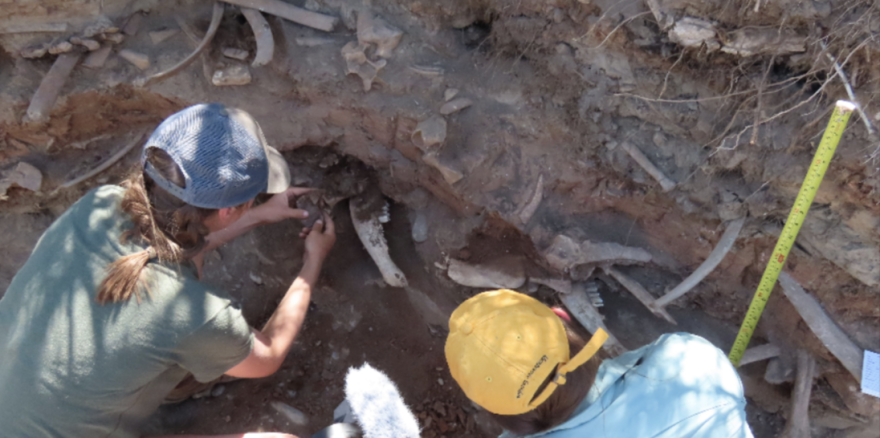The Wiggins Fork Bison Jumps Complex is a high-elevation area in the Absaroka Mountains where different Indigenous tribes worked with and enhanced the landscape’s topography to drive bison off cliffs for harvesting. In comparison to other jumps throughout the state, the site outside of Dubois is big, old, and highly sophisticated, with multiple stone-circle campsites and seven different bison jump sites.
There’s still a lot to learn about the site, which dates back at least 2,000 years. Crystal Reynolds is one of the instructors for a Central Wyoming College (CWC) archaeology field school program and will join the students there for a second summer this June. She’s also the tribal archaeologist for the Northern Arapaho Tribe and said the project is an opportunity to bring together academic and tribal perspectives.

“For so long, there's been an academic voice and there's been science that's proven certain histories and dates. But to tribes, those academic numbers don't really mean anything to us. It's the oral histories and the opportunity to come back to this site and re-make those connections. Our ancestors never really leave,” Reynolds said.
Todd Guenther is the Professor Emeritus of Anthropology and History at CWC and is the other instructor for the college’s field school program at the site. Guenther said working side-by-side with Reynolds, who’s one of his former students, and other tribal members is crucial in telling a more complete picture of the site.
“We're approaching this from different directions to try and create something that is more of a whole than what is often done, where it's one side or the other,” he said.
Guenther started going out to Wiggins Fork with CWC in 2014. About three years ago, he and Reynolds started talking about going to the site together with the field school.
“I grew up in Dubois, so I've known the area and used to travel through there as a kid,” said Reynolds. “But in my position as tribal archaeologist for the Northern Arapaho, I came with a different perspective.”
Reynolds went out to Wiggins Fork with her own crew and spoke to traditional cultural specialists within the tribe, elders, and Eastern Shoshone community members who shared their perspective on the site’s set-up and some of the whys behind its design.
“When we go to a site, we look at the waterways, we look at the migration patterns that are put in over a long time, because animals typically follow the same path,” she said.
For Reynolds, the story of the site as a place of intersections really sparked her interest. She described Wiggins Fork as a geographic stopping-point for many different people moving in different directions – up towards Montana, east to the Dakotas, south into Utah, or west towards Idaho, with what is now Yellowstone National Park at the heart of those travels.
“This was a little hub because Yellowstone is extremely important in many different aspects to a lot of different tribes,” she said. “There's the waters there that are used for making tools, medicines in the park that you can't find in other locations, and a lot of culturally and traditionally important things that come along with the park that have not been forgotten.”
The Wiggins Fork Bison Jumps Complex spans eighteen square miles, with the highest recorded human-constructed stone feature sitting at 8,100 feet high. To Guenther, the complexity and spatial variability of the different bison jumps points to a highly-nuanced understanding of the landscape and migration patterns, as well as an ethic of sustainability.
“Because the topography there is so folded, those other animals wouldn't even know what was going on. Instead of the entire herd of two or five or seven thousand buffalo running away in terror and not coming back for generations, they just kept grazing,” he said.

The team has conducted stable isotope analysis tests on animal bones to better understand migration patterns, and used optically stimulated luminescence and stratigraphic profiles to date the soils. Guenther said that sort of data is similar to looking at tracks in isolation, and that tribal perspectives help tell the story behind where the tracks came from in the first place.
“It's just really important to me that a place that was so important to thousands of other people for thousands of years be treated with the utmost respect possible, both in terms of the spirituality and current tribal needs from multiple different tribes, and also that we do a really good job with the science,” said Guenther.
For Reynolds, the field school at Wiggins Fork is also a rare opportunity for students to learn how to work with different tribes in archaeological settings, which she said isn’t something that’s taught at most field schools across the country.
“I feel like I'm helping develop people that are going to be more tribally receptive in their jobs, they'll have that base knowledge [of respect],” said Reynolds. “They can learn from people that they network with and hopefully bring academic and tribal closer together to be more intertwined.”
Guenther will share about the team’s work at the site on Tuesday, February 27th at the Teton County Library in Jackson. He’ll be joined by two other students on the team – Cadence Truchot, who will be the team’s student crew chief this summer, and Allison Stoff. The presentation is part of CWC’s new speaker series titled “Teton Talks.”







